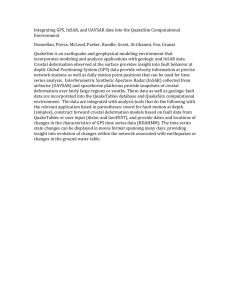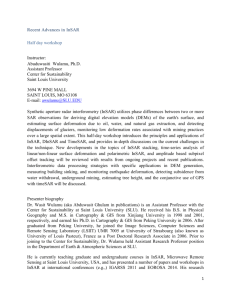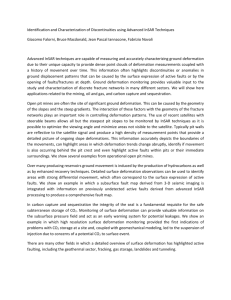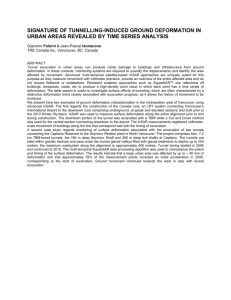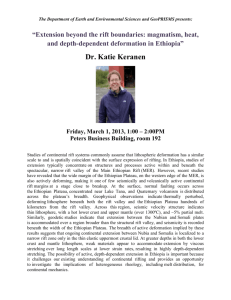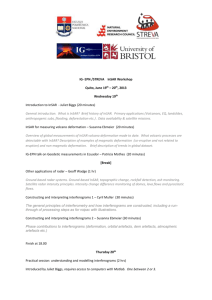grl50470-sup-0001-Hawaii_Supp
advertisement
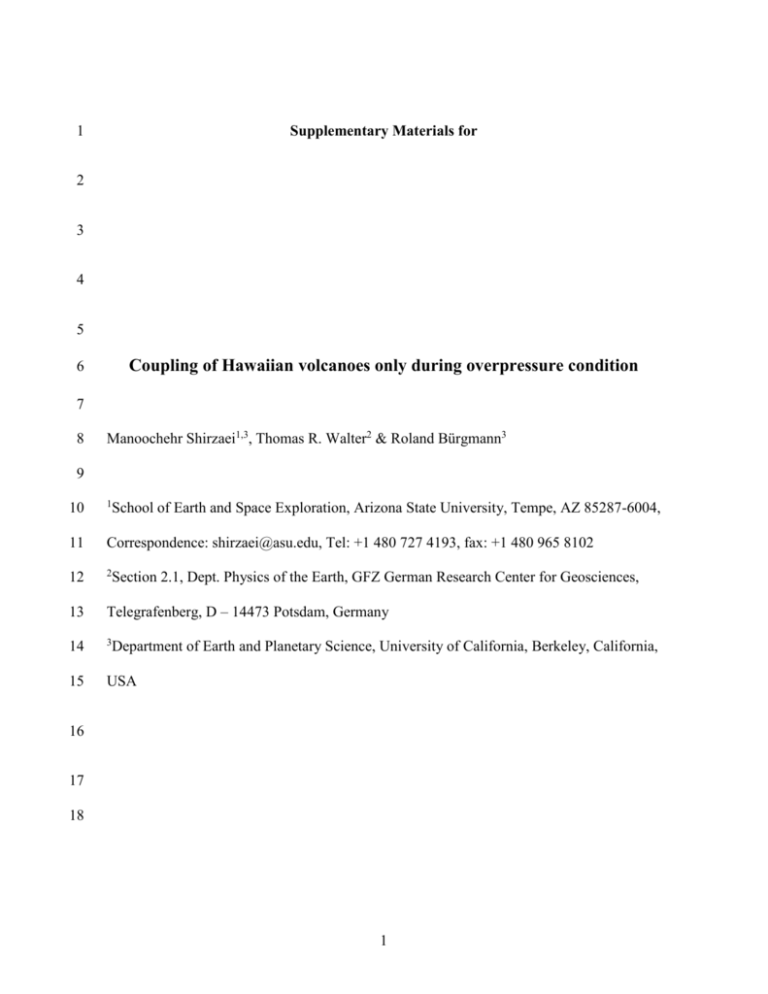
1 Supplementary Materials for 2 3 4 5 Coupling of Hawaiian volcanoes only during overpressure condition 6 7 8 Manoochehr Shirzaei1,3, Thomas R. Walter2 & Roland Bürgmann3 9 10 1 11 Correspondence: shirzaei@asu.edu, Tel: +1 480 727 4193, fax: +1 480 965 8102 12 2 13 Telegrafenberg, D – 14473 Potsdam, Germany 14 3 15 USA School of Earth and Space Exploration, Arizona State University, Tempe, AZ 85287-6004, Section 2.1, Dept. Physics of the Earth, GFZ German Research Center for Geosciences, Department of Earth and Planetary Science, University of California, Berkeley, California, 16 17 18 1 19 GPS data analysis 20 In this study GPS data are only used to validate the InSAR results. The network is operated 21 by Hawaiian Volcano Observatory and University of Hawaii and the data is provided by the 22 UNAVCO Facility with support from the National Science Foundation (NSF) and National 23 Aeronautics and Space Administration (NASA) under NSF Cooperative Agreement No. 24 EAR-0735156. The locations of the GPS stations that are continuously observed during the 25 period of 2003- 2008 are shown in Figure (S1). We use the Bernese 5 software [Dach et al., 26 2007] to solve the daily coordinate of the GPS stations in ITRF2005 reference frame. The 27 precise orbit data are obtained from IGS. To generate a time series of the displacement field 28 for each GPS station we use a Kalman Filter [Hofmann-Wellenhof et al., 2000]. In Fig. S3 29 each GPS displacement sample is the average coordinate of the station within 3 days that 30 temporally spans the InSAR observation point and was projected into the satellite LOS for 31 comparison with the InSAR time series. 32 2 33 References 34 35 36 37 38 39 40 41 42 43 44 45 46 47 Dach, R., U. Hugentobler, P. Fridez, and M. Meindl (2007), Bernese GPS Software Version 5.0, 640 pp., Astronomical Institute, University of Bern, Bern. Hofmann-Wellenhof, B., H. Lichtenegger, and J. Collins (2000), Global Positioning System, Theory and Practice, 5th Edition, 390 pp., Springer, New York. McTigue, D. F. (1987), Elastic stress and deformation near a finite spherical magma body: resolution of the point source paradox, J. Geophys. Res., 92, 12931–12940. Okada, Y. (1985), Surface deformation due to shear and tensile faults in a half-space, Bull. Seism. Soc. Am., 75, 1135-1154. Owen, S., P. Segall, M. Lisowski, A. Miklius, R. Denlinger, and M. Sako (2000), Rapid deformation of Kilauea Volcano: Global Positioning System measurements between 1990 and 1996, J. Geophys. Res., 105(B8), 18,983–918,998. 3 48 Table S1: The initial bounds for dislocation source parameters 49 Parameter Lower bound Upper bound Coordinates (km)* Rift trace – 5 Rift trace + 5 Bottom Depth (km) 6 14 Width (km) 6 14 Dip (deg) 70 110 Depth (km) 2 7 Radius (km) 0.1 Depth lower bound Horizontal location (km) Location of maximum deformation - 5 6 Rift dikes 2 Magma Location of maximum deformation chambers +5 Coordinates (km) Rift trace – 10 Rift trace + 10 1 Basal Depth (km) 6 14 decollement Width (km) 10 30 Dip (deg) -10 10 50 51 52 4 53 54 Fig. S1: Study area and data sets. The location of the Big Island with respect to other 55 Hawaiian Islands is shown in the inset and the boundary of various volcanic systems are 56 outlined. Dashed lines indicate the extent of rift zones of the volcanoes. Recent eruptive 57 activity of Mauna Loa and Kilauea occurred both in the summit caldera region and along 58 the rift zones. The trace of the SAR scene and the location of the stations of the GPS 59 network are shown. 60 5 61 62 Fig. S2: InSAR deformation time series. Spatiotemporal evolution of the deformation field 63 over Hawaii Island obtained by InSAR time series. Each image presents the cumulative 64 displacement since the beginning of the time series. For better illumination the color-scale 65 is saturated beyond -10 cm (i.e. away from satellite) and +10 cm (i.e. toward the satellite). 66 6 67 68 69 Fig. S3: a-i) InSAR deformation validation. Comparison between 3D cGPS time series 70 projected into the line of sight (red dots) and InSAR time series (black dots). j) 71 Quantitative evaluation of the difference between InSAR and cGPS data sets for each 72 station in terms of root mean square error (RMSE). 73 74 7 75 76 77 Fig. S4: Initial configuration of the deformation sources at Hawaii used for inverse 78 modeling. The model comprises an analytical solution for uniform opening (rift) and slip 79 (decollement) on rectangular dislocation planes[Okada, 1985] and volume change of finite 80 spherical sources[Mctigue, 1987] in an elastic half-space medium. 81 8 82 83 Fig. S5: The time series of the deformation source strengths for volcanic sources (a) and 84 tectonic decollement slip (b). Shown are the volumetric changes of the rift zones, magma 85 chamber and basal decollement. The obtained rate for decollement slip compares quite well 86 with what was found in earlier GPS studies of south flank deformation [Owen et al., 2000]. 87 9 88 89 Fig. S6: a) Misfit (observed - modeled) time series and the associated RMSE. b) The 90 spatiotemporal distribution of the misfit for the whole InSAR time series. The areas of the 91 data points, which are not used in the modeling, are masked out. The large misfit in the 92 2007/7/30 image might be due to unmodeled displacement at the eastern rift caused by 93 intrusion during the 2007 Fathers Day episode but also includes remnant artifacts to the 94 north of the rift zone. 10 95 96 Fig. S7: Background seismicity for the period 2003-2008. a) 3D distribution of seismicity 97 for Island of Hawaii. Events are color coded by event year. b) Temporal and spatial 98 distribution of seismicity as a function of distance from Mauna Loa. c) Cumulative number 99 of deep earthquakes (> 20 km) in a circle of 10x10km area around the central caldera at 100 Mauna Loa and Kilauea. Seismicity 101 (http://earthquake.usgs.gov/monitoring/anss/). 102 103 104 11 data courtesy ANSS
